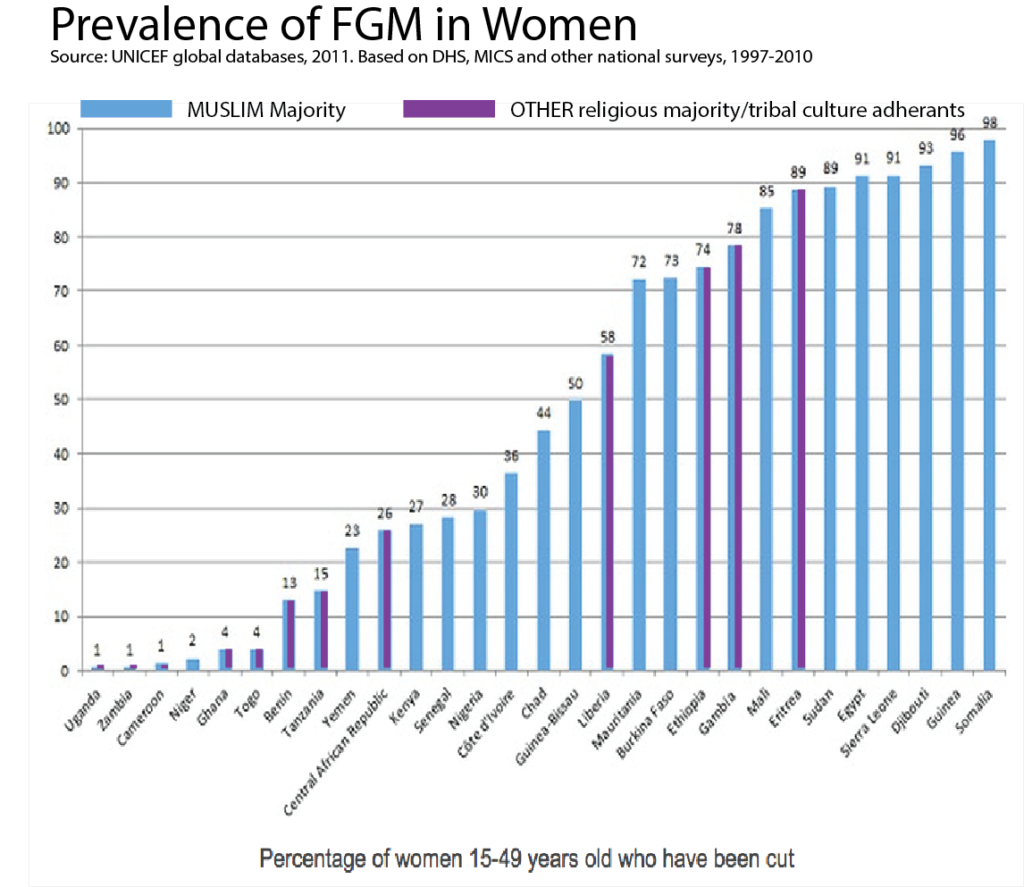Female Genital Mutilation (FGM) or Female Circumcision is widely practiced in Africa and the Middle East and Asia, mostly within and adjacent to Muslim communities. It is maintained both through tribal culture and the practice of Islam and performed often under often horrendous conditions. In 85 percent of cases the clitoris will be completely removed. In one percent of cases the female will die from complications twelve percent will require hospitalisation. The procedure is carried out at a variety of ages, but most commonly occurs between the ages of 4 and 8. In Africa alone, 3 million girls are at risk of FGM each year.
Between 100 and 140 million girls and women worldwide are living with the consequences of FGM. In Africa, about 92 million girls age 10 years and above are estimated to have undergone FGM. In Islamic dominant places like Egypt, Sudan, Sierra Leone, Djibouti, Guinea and Somalia the religious requirement ensures that over 90 percent of the women will have been circumcised.
FGM is now appearing in the West as Islam spreads to Europe, Australia and North America because of Muslim and cultural belief structures concerning female circumcision.
Female Circumcision according to Islam
FGM, varies with the school of Islamic jurisprudence but is mainly considered obligatory:[21]
- The Shafi’i school of Islamic jurisprudence considers female circumcision to be wajib (obligatory).[22]
- The Hanbali school of Islamic jurisprudence considers female circumcision to be makrumah (honorable) and strongly encouraged, to obligatory.[23]
- The Maliki school of Islamic jurisprudence considers female circumcision to be sunnah (optional) and preferred.[23]
- The Hanafi school of Islamic jurisprudence considers female circumcision to be sunnah (preferred).[23]
FATWAS
Fatwas have been justified by Islamic scholars for a number of reasons, two major reasons being to fulfill makrumah granted by Mohammed, and to avoid falling into a taboo behavior.
Some scholars suggest makrumah means that female circumcision adds to the man’s pleasure.
The majority of fatwas that permit or recommend Muslim female circumcision lean toward it being commendable or meritorious act on the part of the woman.
Zakariyya Al-Birri argues it is better to carry out female circumcision, while Al-Qaradawi leaves the choice to parents according to their beliefs, in spite of the fact that he favours female circumcision, because it protects girls’ morality “especially nowadays” claims Al-Qaradawi.[
Similarly, Al-Azhar - one of the most respected universities of the Islamic World in Cairo - has issued a number of fatwas on female circumcision over its history. On June 23, 1951, a fatwa[54] from Al-Azhar declared that it does not recognise the abandonment of female circumcision as an option, and that female circumcision is advisable because it curbs “nature”. Moreover, this fatwa declared doctors’ opinions on the disadvantages of female circumcision as irrelevant.
In 1994 Shaykh Gad al-Haq Ali of al-Azhar issued a fatwa that female circumcision is a part of the legal body of Islam and is a laudable practice that honors women.
Islamic Doctrine on FMG:
FMG gains its support from the following Hadiths:
The Messenger of Allah said: When anyone sits amidst four parts (of the woman) and the circumcised parts touch each other a bath becomes obligatory.
“A man penetrates his wife, but becomes listless and does not ejaculate. She (Aisha) said, “When the circumcised part (male) passes the circumcised part (female), ghusl is obligatory Abu Musa added, “I shall never ask anyone about this after you.”



